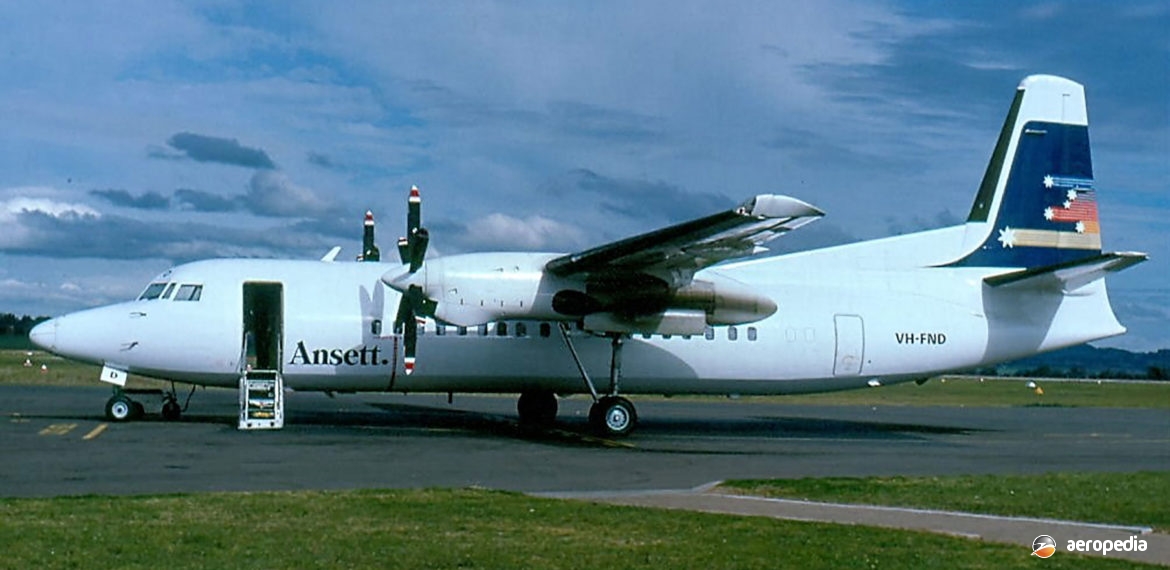Photograph:
Fokker 50 VH-FND (c/n 20109) at Wagga Wagga, NSW in July 1989 (David C Eyre)
Country of origin:
The Netherlands
Description:
Commercial airliner
Power Plant:
Two 1,604 kw (2,150 shp) Pratt & Whitney PW124 turboprops
Specifications:
- Wingspan: 29 m (95 ft 1¾ in)
- Length: 25.19 m (82 ft 7¾ in)
- Height: 8.6 m (28 ft 2½ in)
- Wing area: 70 m² (753.5 sq ft)
- Cruising speed: 532 km/h (330 mph)
- Climbing speed: 370 km/h (230 mph)
- Max operational altitude: 7,620 m (25,000 ft)
- Range with 50 passengers and baggage: 1,390 km (863 miles)
Empty weight: 12,383 kg (27,300 lb)
Loaded weight: 18,990 kg (41,865 lb)
History:
The launch order by Ansett Airlines of Australia early in 1985 for ten examples of the Fokker 50 with an option on a further five aircraft (later converted to an actual order) helped to ensure the initial sales success of the Fokker 50 twin-engine turboprop series of commercial airliners well into the 1990s, and the operation of the series in the Australasian region for some years. Following the launch of the F-27 series in 1953 by Fokker, the type was slowly developed to meet the requirements of operators throughout the world.
In November 1984 the Fokker Company announced the Fokker 50, a design it described as ‘the propjet you asked for’, which was basically an F-27 Friendship with new modern technology engines, new state-of-the-art systems, cockpit and modern construction methods using composite materials wherever possible. The most prominent change was the replacement of the Rolls Royce Dart engines with Pratt & Whitney PW124 three-shaft turboprops, with an installed power of 1,604 kw (2,150 shp) for take-off and 1,165 kw (1,562 shp) at maximum cruising speed at 6,100 m (20,000 ft). Features of the engine included hydro-mechanical engine control supervision by a digital electronic control unit, and new Dowty Rotol six-blade propellers of 3.66 m (12 ft) diameter with digital electronic speed governing and synchronising.
Externally, in appearance, the Fokker 50 differed in having 21 small square windows in lieu of the usual nine oval windows, and twin-nosewheels. Composites were introduced into the secondary structure, these being in the nose cone, nosewheel doors, integral airstairs, wing/fuselage fairings, wing and tail leading-edges, part of the dorsal fin, some fuselage panels and access doors, cabin floor, and almost all of the engine nacelle cowlings.
Accommodation was provided in three main configurations: 46 seats at 86 cm (34 in) pitch; 50 seats at 81 cm (32-in) pitch; or 54 seats at 76 cm (30 in) pitch; although a maximum of 58 could be accommodated on short trips if the forward baggage compartment was reduced in size.
The Fokker 60 Utility was built for The Netherlands Air Force, could carry 50 armed troops and was powered by Pratt & Whitney PW127B turboprops.
The first development aircraft was flown for the first time on 28 December 1985, and deliveries of production aircraft to operators were to commence in mid 1986 but were delayed. Type Certification was received on 15 May 1987. First Ansett aircraft VH-FNA (c/n P006) was delivered in September 1987, and subsequent aircraft were delivered at two a month thereafter. In all, the Ansett group ordered 22 Fokker 50s but at least a dozen were for lease to overseas operators and never entered the Australian Civil Aircraft Register.
Aircraft registered in Australia were registered, which were registered as ‘F-27-050 Fifty’, included: VH-FNA (c/n 20106), VH-FNB (c/n 20107), VH-FNC (c/n 20108), VH-FND (c/n 20109), VH-FNE (c/n 20110), VH-FNF (c/n 20111), VH-FNG (c/n 20112), VH-FNH (c/n 20113), VH-FNI (c/n 20114) and VH-FNJ (c/n 20115). It would seem that during their life in Australia Ansett Airlines had too many Fokker 50s for its routes and they were regularly exchanged between Ansett Australia, Flight West and Skywest.
In due course Ansett Airlines, before its demise, pulled out of the shorter routes in the States and allowed these to be operated by airlines such as Kendell Airlines based at Wagga Wagga, NSW, and Hazelton Airlines based at Cudal, NSW. Five of the Fokker 50s were sold overseas, but five (VH-FNA to VH-FNI) remained in service with Skywest Airlines of Cloverdale, WA. In early 2007 Alliance Airlines placed a Fokker 50 in service, this aircraft becoming VH-FKY (c/n 20284 – ex B12271, PH-MXG), being followed by VH-FKO (c/n 20160).
Further examples have been imported to this region, two arriving in December 2011 for Travel Air in New Guinea, becoming P2-TAH (c/n 20122) and P2-TAG (c/n 20177) bringing the company’s fleet at that time to four examples of the type, the other two being P2-TAE (c/n 20202) and P2-TAF (c/n 20192).
In late 2015 Virgin Australia’s regional arm announced it was disposing of its fleet of Fokker 50s and was acquiring a further four Fokker 100s.
The surviving Fokker 50s were placed in storage for some time at Alice Springs, NT pending sale. In December 2016 VH-FNA left and was flown to Zanzibar, being followed by VH-FND, VH-FNE, VH-FNH and VH-FNI.

